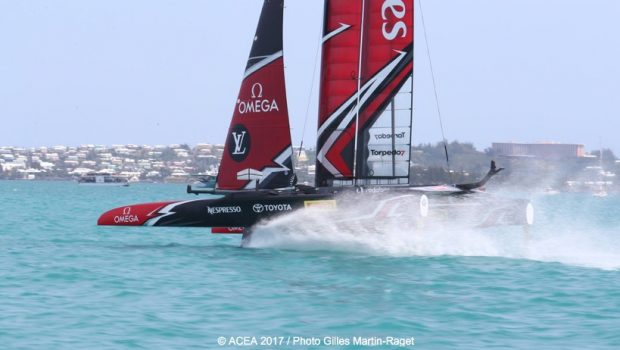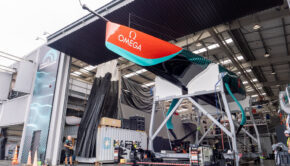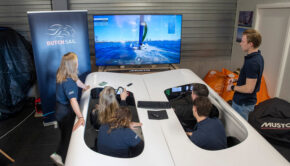Foiling and Foil Shapes, a Beginner’s Guide
Published on June 2nd, 2017
by Mark Chisnell, Land Rover BAR
The rules covering the design and construction of the team’s America’s Cup Class (ACC) boat have defined many of the parts of the boat, including the hull and crossbeams (together called the platform), and the wing shape and size. What’s left for the team’s designers and engineers to work on is principally the daggerboards and rudders, and the control systems that operate them along with the wingsail.
A lot of the technology that goes into the control systems is hidden well inside the hull, with just glimpses of the HMI (human machine interface) that the sailors use to control the board rake, wing trim and so on. The foils are on full view however, so we thought a beginners guide to ACC foil design would come in useful now the racing is approaching.
Basic Principles
The foils use exactly the same scientific principles as an aircraft wing. Just as an aircraft wing will lift a plane up off the ground, the foils of an America’s Cup Class boat will lift it out of the water. Wings are foils too, called aerofoils because they work in air. The foils on the new America’s Cup boats are more accurately called hydrofoils, because they work in water.
The secret to both types of foil is the shape – aerofoils and hydrofoils use a special shape to guide the wind or water around them, and generate the lifting force to get planes and boats up in the air. Of course, the America’s Cup boats also use an aerofoil. The main wingsail works exactly the same way as an aircraft wing, it’s just rotated to stand up straight, rather than lie flat.
While an aircraft needs an engine to push the air over the wing fast enough to generate enough force to lift the aircraft up off the ground, the wingsail on the Cup boat generates force from the wind blowing past it. The harder the wind blows, the more force it makes to push the boat forward. When the boat is going fast enough, the hydrofoils will then be able to create enough force to lift the boat out of the water. This reduces resistance to the forward motion and the boat goes faster still.
There are four hydrofoils on the boat — we count the rudders at the back because they have small wings at the tips called elevators. However, the real power to keep the boat in the air comes from the hydrofoils (the daggerboards, as you will often hear them called by the sailors) and we will concentrate on these.
The L-Foil
The L-foil is exactly that; a vertical daggerboard shaft that goes through the hull of the boat, with a single horizontal hydrofoil on the bottom, the whole thing shaped like an ‘L’. If nothing else changes, then the L-foil keeps generating lift as the boat goes faster and so the boat keeps rising, and as it rises, less and less of the daggerboard is in the water.
At the basic level, two things then happen: firstly, the boat starts to slip sideways because there is less of the vertical part of the daggerboard in the water and this makes the boat feel unstable and hard to steer. Then, ultimately, if the boat keeps rising the horizontal part of the board that is doing all the lifting will break the surface. If it does, there will be a catastrophic loss of lift and the boat will come crashing back down.
Aircraft use moving parts on the foils to control the amount of lift – trailing edge flaps — but the rules forbid these on the ACC boats, so to maintain stable flight the sailors change the rake or angle of attack of the whole dagger board (and hence the foil) to the water.
Rake
If you rake the board backwards as the boat accelerates, the lift will reduce and the boat will come to an equilibrium at a steady height above the water. This is all well and good until the conditions change, maybe the wind speed goes up or down, or the boat hits some waves. When that happens the rake will need further adjustment to find the new equilibrium… until the next puff or lull when it must change again.
In the big breeze and rough water of San Francisco Bay in the 34th America’s Cup it turned out that these moments of equilibrium didn’t last very long and on occasions barely existed at all. The crew’s ability to generate the hydraulic power to change the board and wing trim was simply overwhelmed; they couldn’t achieve stable flight.
V-foil
The solution was what’s called the V-foil, in which the horizontal part of the ‘L’ is angled upwards to form more of a ‘V’ shape (the angle at the bottom of the ‘V’ is called the dihedral – a dihedral of 90 degrees would define an L-foil, less than that is progressively more of a V-foil).
The V-foil uses the same principle as one of the most successful original foiling powerboats. The grand old man of 19th century innovation, Alexander Graham Bell put a couple of 350hp engines on the back of what was called HD-4 and set a new marine world speed record in 1919 of just over 70mph.
HD-4 used three ‘ladders’ of small foils, one at the front, and one each side close to the back. When the boat accelerated it started to lift out of the water, and as it lifted, one by one the ‘rungs’ of the foils would break clear of the water. As they did so the lift would decrease, and unless the boat continued to accelerate the boat would stop rising and settle at an equilibrium.
The V-foil achieves this same effect with a single foil and is used in the commercial application of fast ferries— one runs between Southampton and Cowes on the Isle of Wight, right across the Solent waters where the team train, and has done so (on and off) since 1969 – so V-foils are well understood.
When a boat equipped with a V-foil keeps rising as more lift is generated by faster speeds, both parts of the ‘V’ come out of the water together. Critically, when the ‘horizontal’ section starts to break the surface at the tip, it has the effect of reducing the lift gradually, because it doesn’t all come out of the water together. So the boat comes back down gently, working towards an equilibrium ‘ride height’ of its own accord.
It might be that it doesn’t reach this equilibrium before something else changes, but the V-foil has some inherent stability (unlike the L-foil) that doesn’t require human intervention. The shape provides a feedback mechanism to control the amount of lift and produce a more stable ride at a consistent height above the water. The downside of the V-foil is that it will generate less lift and more drag than the L-foil under the same conditions, because some of the lift generated is pushing sideways rather than up.
So one of the big questions facing the teams at the outset of this campaign was whether or not the sailors could achieve stable flight with an L-foil in the new boats and the new venue. Bermuda was a very different place to San Francisco; the winds were expected to be lighter, the water flatter and it seemed that stable flight should be easier to achieve with an L-foil under human control.
A huge amount of work has gone into foil and control system design and we now know that the answer is yes, they can – all the teams are using L-foils, often with unloaded dihedral angles of greater than 90 degrees. These angles close as the boat sails and the foil is loaded up to become much closer to, or 90 degrees.
Cant
Another buzz word for the 35th America’s Cup is the cant. The cant of the board is similar to the rake, except that the bottom of the board is moving sideways across the boat, to and from the centreline, rather than backwards and forwards. When the board is canted outwards (towards the edge of the boat) it creates greater ‘righting moment’ and more power to drive the boat forwards.
Righting Moment
When the wind hits a sail it creates the force to move the boat forward but it also creates a force that is trying to tip the boat over. If you have ever seen a dinghy or yacht knocked flat by a big gust of wind then you’ve already got the idea.
It’s considerably simplified, but essentially the more force that can be applied to resist the wind’s effort to tip the boat over, then the faster the boat will go, because more of the wind’s energy can be captured and applied to forward motion. The resisting force is called the righting moment and creating as much righting moment as possible is a fundamental principle of designing fast sailboats. It’s the reason that you see people leaning over the windward side when they are racing, putting bodies as far out on the windward side as possible is creating righting moment.
S-Foil
Finally, there’s the question of whether the vertical part of the daggerboard should be straight or ‘S’ shaped. The curve of the S-foil could be used — like the cant — to move the bottom of the board outboard and increase the righting moment. So S-foils are more powerful, but they are also more difficult to use. The curves have to raised up and down through the bearings and internal mechanisms in the hull, and that means a lot of work to keep the friction down and the efficiency high.









 We’ll keep your information safe.
We’ll keep your information safe.